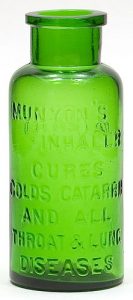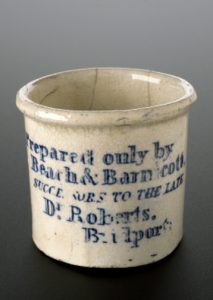19th century
Atkinson & Barker’s Royal Infants’ Preservative
Source: The Patriot (London) 12 September 1853 It is no misnomer Cordial! —no stupefactive, deadly narcotic! —but a veritable preservative of Infants! Regular readers of The Quack Doctor might be able to hazard a guess at the active ingredients of this product. Like other infant quieteners, it did contain a narcotic, and, like them, it […]
Read More
Munyon is ready…
Would you buy a homeopathic remedy from this man? Source: The Morning Times (Washington D.C.) 13 December 1896 James Monroe Munyon’s pompadour hairstyle was a familiar feature of American newspapers around the turn of the 20th century. Having tried his hand at teaching, law, social work, publishing and song-writing, he started his Homoeopathic Home Remedy […]
Read MoreGamjee’s Oriental Salve
During the next couple of weeks I’m featuring some of the ads that have slipped through the net – either I can’t find out much about them, or I’ve already written about something similar. The brief British season of thinking it might be nice to play tennis is now coming to an end. The crumbling […]
Read MoreProfessor Modevi’s Beard Generator
While some historical quacks and their remedies remain famous, I often find adverts for products that have faded into obscurity. Some were one-hit wonders that only appeared in the papers for a few weeks, while others were well known in their time but don’t have much extant background information associated with them. There are also […]
Read More
The Poor Man’s Friend
Source: Trewman’s Exeter Flying Post, 20 July 1826 In 2003, the Daily Mail ran a story titled: Beeswax is ‘miracle’ cure. The article referred to an 18th/19th-century ointment called The Poor Man’s Friend, a popular remedy for wounds and skin conditions. The reason it hit the 21st-century press was that its inventor’s original secret recipe had […]
Read MoreThe ‘Instra’ Warmer
Source: The Sporting Times, 28 January 1899. Although this product isn’t solely medical, its advertising did claim that it could prevent chills, colds, rheumatism and lumbago, and alleviate toothache, neuralgia and sciatica. Whether or not it could effectively combat these ailments is doubtful, but it nevertheless sounds like a useful gadget for the depths of […]
Read MoreBarrett’s Mandrake Embrocation
BARRETT’S Mandrake EMBROCATION CURES {HEADACHE! EARACHE! TOOTHACHE!} INSTANTLY. Unequalled for Sprains, Bruises, Overstraining of the Muscles, Cramp, Rheumatism, Sciatica, Lumbago, Gout, Neuralgia, Chilblains, Bronchitis. To be had retail of all Chemists, 1s. 1½d., 2s. 9d., and 4s. 6d., postage 3d. extra ; or direct from the Sole Proprietor, JOSHUA BARRETT, 21, Beresford Road, Highbury New […]
Read MoreCameron the Piss-Prophet
It is surprising the number of Persons that apply daily from 11 o’clock till 3, at No. 84, Wells-street, Oxford-street, to consult Dr. Cameron, who discovers disorders by an inspection of the morning urine, and although Dr. C.’s method is singular, it it (sic) a well known fact, that he restores many to perfect health, […]
Read MoreVigor’s Horse-Action Saddle
Source: Country Life Illustrated, 8 Jan 1897 (this image from a later facsimile edition) Unusually for anything involving exercise, this contraption looks almost fun. Although perhaps not completely ‘a perfect substitute for a live horse’ – at least, not if you wanted to travel somewhere – it was well-received as an aid to fitness. The medical […]
Read MoreHomeopathy made plain to the meanest capacity
Today marks the beginning of World Homeopathy Awareness Week. When homeopathy was introduced to Britain in the 1830s, not everyone was clear on what this new-fangled system was all about. Here’s an explanation from Mr Waggle, a character in Cornelius Webbe’s The Man About Town (1838). Waggle is a well-preserved 45-year-old bachelor who never stops […]
Read More